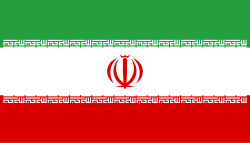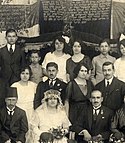Mizrachim
| Mizrachim מזרחים | |
|---|---|
 | |
| Populace | |
| 4,6 mil. (2018)[1] | |
| 3 232 800 (2018)[2] | |
| 8 756 (2012)[3] | |
| < 20 (2017)[4][5] | |
| 50 (2016)[6] | |
| Přes 30 000 | |
| 11 000–30 000 | |
| 300 000+ | |
| 40 000 | |
| 250 000 | |
| 109 | |
| Jazyk(y) | |
| hebrejština, arabština, gruzínština, maráthština, perština | |
| Náboženství | |
| judaismus | |
| Příbuzné národy | |
| Aškenazim, Sfaradim, Arabové, Horští Židé | |
Mizrachim (anglicky Mizrahi Jews, hebrejsky מזרחים nebo také עדות המזרח, edot ha-mizrach) jsou Židé pocházející ze severní Afriky, Kavkazského pásma a zemí blízkého a středního východu. Mezi Mizrachim patří Židé z Iráku, Sýrie, Libanonu, Jemenu, Íránu, Afghánistánu, Uzbekistánu, severního a východního Súdánu a také Etiopie. Nesprávně jsou někdy mezi Mizrachim zahrnováni i sefardští židé z Turecka a severní Afriky.
I přes masovou imigraci Aškenázů v 90. letech 20. století tvoří přibližně polovinu celkové židovské populace Izraele.[7]
Původ jména
Mizrachi pochází z hebrejského slova מזרח (mizrach), v překladu východ, a koresponduje s hebrejským termínem ma'arav (západ).
Odkazy
Reference
- ↑ No, Israel is not a country of privileged and powerful white Europeans [online]. 20 May 2019 [cit. 2019-09-26]. Dostupné online. (anglicky)
- ↑ Ethnic origin and identity in the Jewish population of Israel [online]. Journal of Ethnic and MIgration Studies, 27 June 2018 [cit. 2019-09-26]. Dostupné online. (anglicky)
- ↑ Jewish woman brutally murdered in Iran over property dispute [online]. The Times of Israel, 28 November 2012 [cit. 2014-08-16]. Dostupné online. (anglicky)
- ↑ Egypt's Jewish community diminished to 6 women after death of Lucy Saul [online]. [cit. 2017-03-03]. Dostupné online. (anglicky)
- ↑ Muslims in Egypt are trying to preserve its Jewish heritage. The Economist. 5 September 2017. Dostupné online. (anglicky)
- ↑ Some of the last Jews of Yemen brought to Israel in secret mission. The Jerusalem Post. 21 March 2016. Dostupné online [cit. 14 September 2016]. (anglicky)
- ↑ http://www.jewishvirtuallibrary.org/jsource/Judaism/mejews.html
Bibliografie
- Ella Shohat, "The Invention of the Mizrahim," Journal of Palestine Studies, Vol. 29, No. 1 (Autumn, 1999), pp. 5-20
- ZAKEN, Mordechai. Jewish Subjects and Their Tribal Chieftains in Kurdistan: A Study in Survival. Boston and Leiden: Brill, 2007. (anglicky)
Související články
Externí odkazy
 Obrázky, zvuky či videa k tématu Mizrachim na Wikimedia Commons
Obrázky, zvuky či videa k tématu Mizrachim na Wikimedia Commons
Média použitá na této stránce
Flag of Iran. The tricolor flag was introduced in 1906, but after the Islamic Revolution of 1979 the Arabic words 'Allahu akbar' ('God is great'), written in the Kufic script of the Qur'an and repeated 22 times, were added to the red and green strips where they border the white central strip and in the middle is the emblem of Iran (which is a stylized Persian alphabet of the Arabic word Allah ("God")).
The official ISIRI standard (translation at FotW) gives two slightly different methods of construction for the flag: a compass-and-straightedge construction used for File:Flag of Iran (official).svg, and a "simplified" construction sheet with rational numbers used for this file.
Photograph of Jewish wedding party in Aleppo, in 1914 by the Armenian photographer Derounian. Men, women, and children, are all dressed in European fashion, except for one Fez wearing family member. Dr Alex Russell, M.D. attended many weddings in Aleppo in the 18th. century during his long residence there , and made the following observation during a Jewish wedding, " The bride is seated in an open arm-chair, in the middle of the open Divan, or Alcove, with three enormous painted wax tapers burning before her. She is covered with a red gauze veil, through which her face and dress are plainly enough discernable. She is richly dressed in Venetian silks, and besides the usual jewels of gold, she is adorned with precious stones, and a profusion of pearls. " THE NATURAL HISTORY OF ALEPPO 1794 LONDON.









